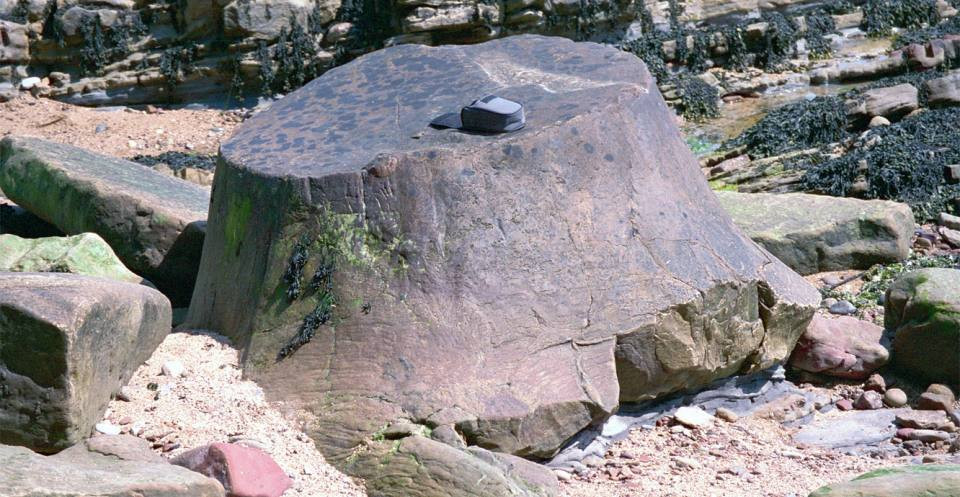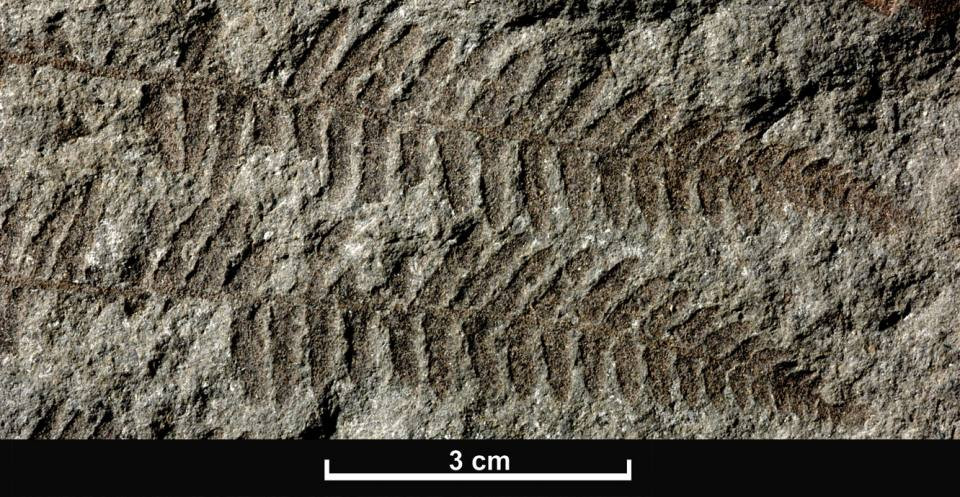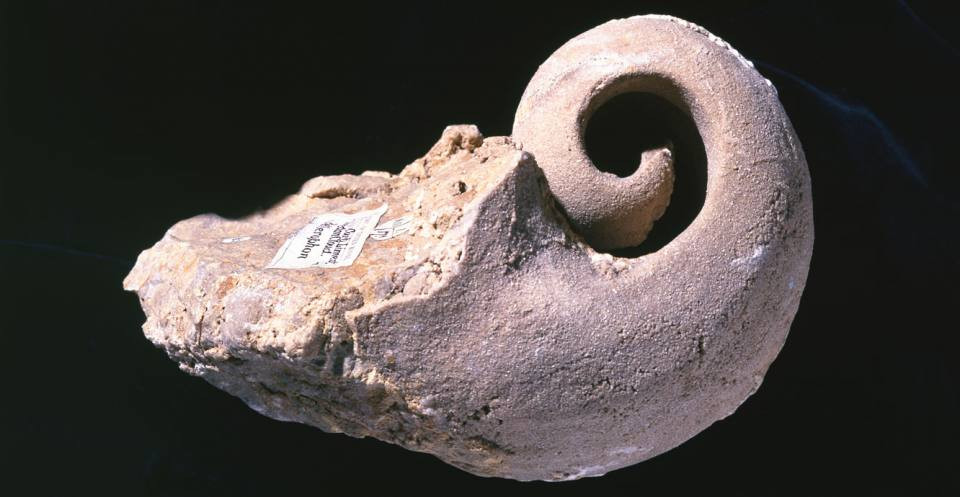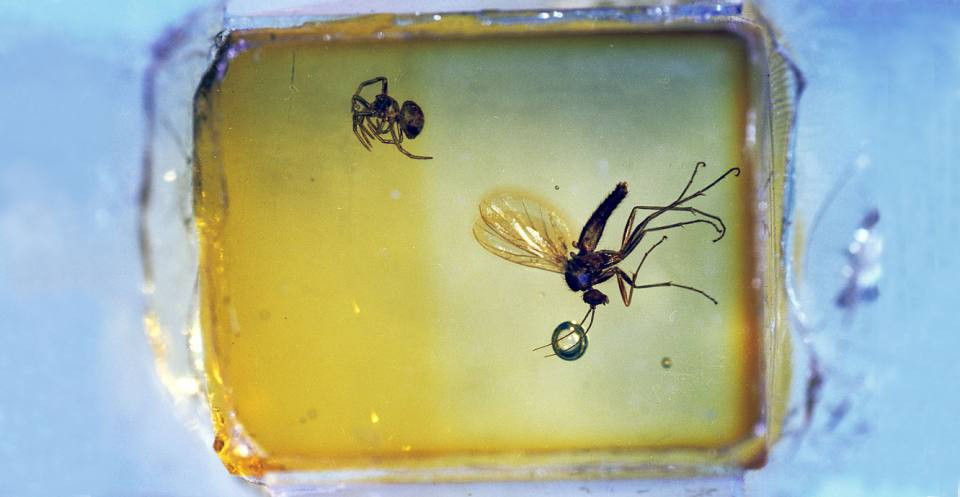Fossil formation in rocks is a captivating process that unveils Earth’s ancient history, and at rockscapes.net, we’re passionate about bringing this history to your landscape. This in-depth guide explores the fascinating journey of how organic remains transform into the stony relics we call fossils, enhancing your appreciation for these natural wonders and their potential use in your outdoor spaces. Dive into the world of petrification, compression, molds, casts, and preserved remains, and learn how these processes create lasting testaments to prehistoric life and geological history.
1. What Exactly Are Fossils and How Do They Relate to Rocks?
Fossils are the preserved remains or traces of ancient plants, animals, and other organisms that have been entombed in geological formations for thousands or even millions of years. They provide a unique window into past ecosystems and the evolution of life on Earth.
Fossils come in various forms, including:
- Body Fossils: These are the actual remains of an organism, such as bones, shells, teeth, or even soft tissues preserved under exceptional circumstances.
- Trace Fossils: These are indirect evidence of life, such as footprints, burrows, coprolites (fossilized dung), and other impressions left by organisms in sediment.
Rocks, particularly sedimentary rocks, serve as the primary medium for fossil preservation. Sedimentary rocks are formed from the accumulation and cementation of sediments like sand, mud, and silt. These sediments can bury organic remains, protecting them from decay and erosion, and creating the conditions necessary for fossilization.
2. What Are the Key Conditions Required for Fossil Formation in Rocks?
Fossil formation is a rare event, requiring a specific set of conditions to occur. Here are the most important factors:
- Rapid Burial: The rapid burial of organic remains is crucial for protecting them from scavengers, decomposition, and other destructive processes. Sedimentation rates must be high enough to quickly cover the organism, preventing its complete disintegration.
- Presence of Hard Parts: Organisms with hard parts, such as bones, shells, and teeth, are more likely to be fossilized than those with only soft tissues. Hard parts are more resistant to decay and can withstand the pressures of burial and fossilization.
- Anoxic Environment: A lack of oxygen (anoxia) can slow down the decomposition process, increasing the chances of fossil preservation. Anoxic conditions are often found in deep marine environments or stagnant bodies of water.
- Mineral-Rich Groundwater: The presence of mineral-rich groundwater is essential for the permineralization process, where minerals replace the organic material of the organism, turning it into stone.
- Lack of Disturbance: The fossilization process can be disrupted by geological events such as earthquakes, volcanic eruptions, or erosion. A stable geological environment is necessary for successful fossil formation.
3. Where Can Fossils Be Found?
Fossils are typically found in sedimentary rocks, which are formed from accumulated sediments over millions of years. Common locations include:
- Shale: Formed from compressed mud or clay, shale often contains detailed impressions of plant and marine life.
- Limestone: This sedimentary rock, primarily made of calcium carbonate, is ideal for preserving marine organisms like shells and coral.
- Sandstone: Created from cemented sand grains, sandstone can encapsulate footprints and skeletal remains of terrestrial animals.
- Coal: This organic sedimentary rock is rich with fossilized plant matter from ancient swamps and forests.
Fossils can also be found in:
- Amber: Fossilized tree resin that traps and preserves insects and small organisms.
- Tar Pits: Natural asphalt deposits that preserve bones of animals that become trapped.
- Ice: Frozen environments that can preserve soft tissues and even entire bodies of animals like mammoths.
4. What Is the Process of Fossilization?
The process of fossilization is complex and can take many different paths, depending on the environmental conditions and the type of organism involved. Here are the most common types of fossilization:
4.1 Petrification
Petrification, also known as permineralization, is the most common type of fossilization. It occurs when mineral-rich fluids seep into the porous spaces of an organism’s remains, such as bones or wood. Over time, these minerals precipitate out of the solution and fill the spaces, hardening the remains into stone.
 Petrified tree stump showcasing permineralization.
Petrified tree stump showcasing permineralization.
According to research from Arizona State University’s School of Earth and Space Exploration, petrification often occurs in environments where groundwater is saturated with minerals like silica, calcite, or iron oxides. These minerals gradually replace the organic material of the organism, preserving its original shape and structure.
4.2 Compression
Compression occurs when an organism is buried under layers of sediment, and the weight of the overlying material compresses the remains. This process is common for plant fossils, where the plant material is flattened and carbonized, leaving a dark imprint on the rock.
 Compressed plant leaves and ferns from the Jurassic Period.
Compressed plant leaves and ferns from the Jurassic Period.
The resulting fossils are typically two-dimensional, showing the outline and some details of the original organism. Compression fossils can provide valuable information about the size, shape, and structure of ancient plants.
4.3 Moulds and Casts
Moulds and casts are formed when an organism is buried in sediment, and its remains eventually dissolve away, leaving a cavity in the rock. This cavity is called a mould. If the mould is later filled with sediment or minerals, it creates a cast, which is a three-dimensional replica of the original organism.
 Mould of an ancient snail or slug (Bellerophon).
Mould of an ancient snail or slug (Bellerophon).
Moulds and casts are particularly common for shelled organisms like snails and clams, where the shell dissolves away, leaving a detailed impression in the rock.
4.4 Preserved Remains
In rare cases, organisms can be preserved in their original state, without significant alteration or replacement of their tissues. This type of fossilization is most common in environments where decay is inhibited, such as:
- Amber: Insects and other small organisms can be trapped in tree resin, which hardens into amber over time, preserving the organism in exquisite detail.
 Fly and spider perfectly preserved in amber.
Fly and spider perfectly preserved in amber.
-
Ice: Animals can be frozen in ice, preserving their soft tissues and even their DNA.
-
Tar Pits: Animals can be trapped in tar pits, where the thick, sticky asphalt prevents decay and preserves their bones.
5. What Role Does Rock Type Play in Fossilization?
Rock type is crucial for fossil preservation. The most common types are sedimentary rocks, which include shale, limestone, and sandstone. Here’s how each rock type affects fossilization:
- Shale: Fine-grained and formed from clay, shale is excellent for preserving detailed impressions of plants and marine life. Its layered structure allows for fossils to be easily split and revealed.
- Limestone: Composed of calcium carbonate, limestone is ideal for preserving marine organisms such as shells and coral. The alkaline environment can protect remains from acidic decay.
- Sandstone: Made of cemented sand grains, sandstone often preserves larger fossils like footprints and skeletal remains of terrestrial animals. Its porous nature allows for mineral replacement and petrification.
- Coal: This organic sedimentary rock is formed from accumulated plant matter, creating an environment rich for preserving fossilized plant material from ancient swamps and forests.
6. Why Are Fossils Important?
Fossils are incredibly important for several reasons:
- Understanding Evolution: Fossils provide direct evidence of the evolution of life on Earth, showing how organisms have changed over time. They help us understand the relationships between different species and the processes that drive evolutionary change.
- Reconstructing Past Environments: Fossils can tell us about the environments in which ancient organisms lived. By studying the types of fossils found in a particular rock formation, we can learn about the climate, geography, and ecology of that area in the past.
- Dating Rocks: Fossils can be used to date rocks, helping geologists to understand the age and sequence of geological events. Certain fossils, called index fossils, are particularly useful for dating rocks because they are widespread, abundant, and lived for a relatively short period of time.
- Finding Resources: Fossils can be used to locate deposits of oil, natural gas, and other valuable resources. For example, the presence of certain types of marine fossils can indicate the presence of oil-rich shale formations.
7. How Can Fossils Be Used in Landscaping?
Fossils can add a unique and fascinating touch to your landscaping, bringing a sense of history and natural beauty to your outdoor spaces. Here are some ways to incorporate fossils into your landscape:
- Fossil Display: Create a display of fossil specimens in your garden or patio. You can use a variety of different fossils, such as ammonites, trilobites, and fossilized wood, to create an interesting and educational exhibit.
- Fossil Pathways: Use fossil-rich rocks to create pathways or stepping stones in your garden. This will add a touch of natural history to your landscape and provide a unique talking point for visitors.
- Fossil Walls: Build walls or retaining walls using rocks that contain fossils. This will create a stunning and eye-catching feature in your landscape.
- Fossil Water Features: Incorporate fossils into water features such as fountains or ponds. The fossils will add a touch of natural beauty and interest to the water feature.
At rockscapes.net, we offer a wide variety of fossil-rich rocks and specimens that can be used to enhance your landscaping. Contact us today to learn more about our selection and how we can help you create a unique and beautiful outdoor space.
8. How Do Paleontologists Study Fossils?
Paleontologists use a variety of techniques to study fossils and learn about ancient life. Here are some of the most common methods:
- Excavation: Paleontologists carefully excavate fossils from rock formations, using tools such as shovels, picks, and brushes. They document the location and orientation of each fossil, as well as the surrounding rock layers.
- Preparation: Once the fossils have been excavated, they are carefully cleaned and prepared in the laboratory. This may involve removing excess rock, consolidating fragile areas, and reconstructing broken pieces.
- Identification: Paleontologists identify fossils by comparing them to known species and using taxonomic keys. They may also use microscopic analysis and other techniques to study the fine details of the fossils.
- Dating: Paleontologists use a variety of methods to date fossils, including radiometric dating, biostratigraphy, and magnetostratigraphy. These methods allow them to determine the age of the fossils and the rocks in which they are found.
- Analysis: Paleontologists analyze fossils to learn about the biology, ecology, and evolution of ancient organisms. They may study the shape and structure of the fossils, as well as their chemical composition and isotopic signatures.
9. What Are Some Famous Fossil Sites Around the World?
Numerous locations worldwide are renowned for their exceptional fossil discoveries. Here are a few notable sites:
- Burgess Shale, Canada: This UNESCO World Heritage Site is famous for its exceptionally well-preserved fossils of soft-bodied organisms from the Cambrian period.
- Messel Pit, Germany: This former oil shale quarry is known for its remarkable fossils of mammals, birds, reptiles, and insects from the Eocene epoch.
- La Brea Tar Pits, USA: Located in Los Angeles, California, these natural asphalt deposits have preserved the bones of thousands of animals, including mammoths, saber-toothed cats, and dire wolves.
- Yixian Formation, China: This geological formation is famous for its feathered dinosaur fossils, which have provided valuable insights into the evolution of birds.
- Karoo Supergroup, South Africa: This vast geological region contains a rich record of vertebrate fossils from the Permian and Triassic periods, including early mammal-like reptiles.
10. What Are Some of the Most Significant Fossil Discoveries?
Several fossil discoveries have significantly impacted our understanding of life’s history. Here are a few examples:
- Archaeopteryx: This fossil, discovered in Germany in the 1860s, is considered a transitional fossil between dinosaurs and birds, providing crucial evidence for the theory of evolution.
- Lucy: This fossil skeleton, discovered in Ethiopia in 1974, is one of the most complete hominin fossils ever found. Lucy belonged to the species Australopithecus afarensis and lived about 3.2 million years ago.
- Tiktaalik: This fossil, discovered in Canada in 2004, is a transitional fossil between fish and tetrapods (four-legged animals). Tiktaalik had features of both fish and tetrapods, providing insights into the evolution of land-dwelling vertebrates.
- Sinosauropteryx: This fossil, discovered in China in 1996, was the first dinosaur fossil found with evidence of feathers. Sinosauropteryx was a small, carnivorous dinosaur that lived about 125 million years ago.
- Hallucigenia: This fossil, discovered in the Burgess Shale, is one of the most bizarre and enigmatic fossils ever found. Hallucigenia was a small, worm-like creature with spines on its back and legs with claws.
FAQ: How Do Fossils Form in Rocks
1. What types of organisms can become fossils?
Any organism, from microscopic bacteria to giant dinosaurs, can potentially become a fossil, provided the right conditions are met. However, organisms with hard parts, such as bones, shells, and teeth, are more likely to be fossilized than those with only soft tissues.
2. How long does it take for a fossil to form?
The fossilization process can take thousands or even millions of years, depending on the environmental conditions and the type of organism involved. In some cases, such as the preservation of insects in amber, the process can be relatively rapid, taking only a few years or decades. However, in most cases, fossilization is a slow and gradual process that requires long periods of time.
3. Can soft tissues be fossilized?
Yes, in rare cases, soft tissues can be fossilized. This typically occurs in environments where decay is inhibited, such as in amber, ice, or tar pits. Soft tissue preservation can provide valuable insights into the anatomy and biology of ancient organisms.
4. What is the difference between a fossil and a subfossil?
A fossil is typically defined as the preserved remains of an organism that lived more than 10,000 years ago. A subfossil is a more recent remain, typically less than 10,000 years old. Subfossils are often found in caves, swamps, and other environments where preservation conditions are favorable.
5. What is an index fossil?
An index fossil is a type of fossil that is particularly useful for dating rocks. Index fossils are typically widespread, abundant, and lived for a relatively short period of time. The presence of a particular index fossil in a rock formation can indicate the age of the rock.
6. What are the main types of fossilization?
The main types of fossilization include petrification (permineralization), compression, molds and casts, and preserved remains. Each type of fossilization involves different processes and results in different types of fossils.
7. How do geologists use fossils?
Geologists use fossils to date rocks, reconstruct past environments, and understand the evolution of life on Earth. Fossils are one of the most important tools that geologists use to study the history of our planet.
8. Where is the best place to find fossils?
The best place to find fossils depends on the type of fossils you are looking for. Sedimentary rocks, such as shale, limestone, and sandstone, are the most likely places to find fossils. Specific locations, such as the Burgess Shale in Canada or the La Brea Tar Pits in the United States, are famous for their exceptional fossil discoveries.
9. What tools do paleontologists use to find fossils?
Paleontologists use a variety of tools to find fossils, including shovels, picks, brushes, and dental tools. They also use geological maps and other resources to identify promising locations for fossil hunting.
10. How can I identify a fossil?
Identifying a fossil can be challenging, especially for beginners. It is helpful to compare the fossil to known species and use taxonomic keys. Online resources, museums, and local fossil clubs can also provide assistance with fossil identification.
Understanding how fossils form in rocks opens a window into Earth’s deep history, offering valuable insights into the evolution of life and past environments. At rockscapes.net, we’re excited to help you bring a piece of this history into your own landscape.
Ready to add a touch of prehistoric wonder to your outdoor space? Visit rockscapes.net today to explore our unique collection of fossil-rich rocks and discover how you can create a landscape that tells a story millions of years in the making. Contact us at 1151 S Forest Ave, Tempe, AZ 85281, United States or call +1 (480) 965-9011 to speak with our experts and start your fossil-inspired landscaping journey.
